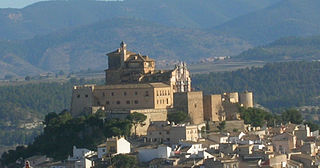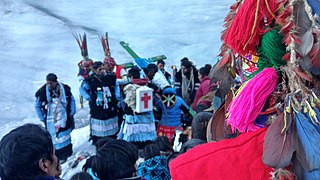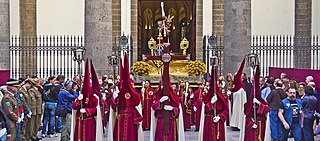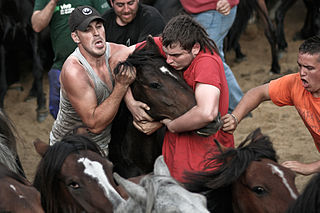
Galicia is an autonomous community of Spain and historic nationality under Spanish law. Located in the northwest Iberian Peninsula, it includes the provinces of A Coruña, Lugo, Ourense, and Pontevedra.

May Day is a European festival of ancient origins marking the beginning of summer, usually celebrated on 1 May, around halfway between the spring equinox and summer solstice. Festivities may also be held the night before, known as May Eve. Traditions often include gathering wildflowers and green branches, weaving floral garlands, crowning a May Queen, and setting up a Maypole, May Tree or May Bush, around which people dance. Bonfires are also part of the festival in some regions. Regional varieties and related traditions include Walpurgis Night in central and northern Europe, the Gaelic festival Beltane, the Welsh festival Calan Mai, and May devotions to the Blessed Virgin Mary. It has also been associated with the ancient Roman festival Floralia.

Pentecost is a Christian holiday which takes place on the 49th day after Easter Sunday. It commemorates the descent of the Holy Spirit upon Mary, mother of Jesus and the Apostles of Jesus while they were in Jerusalem celebrating the Feast of Weeks, as described in the Acts of the Apostles. While the Catholic Church believes the Holy Spirit descended upon Mary, this is not recorded in the New Testament.

In Gallo-Roman religion, Epona was a protector of horses, ponies, donkeys, and mules. She was particularly a goddess of fertility, as shown by her attributes of a patera, cornucopia, ears of grain, and the presence of foals in some sculptures. She and her horses might also have been leaders of the soul in the after-life ride, with later literary parallels in Rhiannon of the Mabinogion. The worship of Epona, "the sole Celtic divinity ultimately worshipped in Rome itself", as the patroness of cavalry, was widespread in the Roman Empire between the first and third centuries AD; this is unusual for a Celtic deity, most of whom were associated with specific localities.

The festival of San Fermín is a week-long, historically rooted celebration held annually in the city of Pamplona, Navarre, Spain. The celebrations start at noon on 6 July and continue until midnight on 14 July. A firework (Chupinazo) starts off the celebrations and the popular song Pobre de mí is sung at the end. The most famous event is the running of the bulls, which begins at 8 a.m. each day on 7–14 July, but the festival involves many other traditional and folkloric events. It is known locally as Sanfermines in Spanish and Sanferminak in Basque, and is held in honour of Saint Fermin, the co-patron of Navarre.

Viveiro is a town and municipality in the province of Lugo, in the autonomous community of Galicia, Spain. It belongs to the comarca of A Mariña Occidental. It borders on the Cantabrian Sea, to the west of Xove and to the east of O Vicedo. It has a residential population of over 16,000, which however triples in the summer months with visitors to the coastal region.

A common riding is an equestrian tradition mainly in the Scottish Borders in Scotland. Male and female riders ride out of the town and along its borders to commemorate the practice from 13th and 15th centuries where there were frequent raids on the Anglo-Scottish border known as the Border Reivers and also to commemorate the Scottish defeat at the Battle of Flodden. Today, the common ridings, rideouts, or riding of the marches continue to be annual events celebrated in the summer in the Borders of Scotland. Each town may have many rideouts over their festival week, usually having one on festival day. Some towns re-enact historic 'common ridings' – although many others have well-established 'festival rides' that are cemented within their town's history. The common riding towns are: Berwick-upon-Tweed, Hawick, Selkirk, Langholm, Lockerbie, Jedburgh, Coldstream, Penicuik, West Linton, Lanark, Lauder, Edinburgh, Melrose, Musselburgh, Galashiels, Duns, Sanquhar, and Peebles.

Caravaca de la Cruz, often shortened to Caravaca, is a town and municipality of southeastern Spain in the region of Murcia, near the left bank of the River Argos, a tributary of the Segura. It is the capital of the northwest Region of Murcia. It has a population of 26,449 as of 2010. In 1900, it had 15,846 inhabitants.
Villamañán is a town located in the south-west of the province of León, Spain, in the area known as Esla, in the autonomous community of Castile and León in Spain.

Pé de Serra is a Brazilian municipality in the state of Bahia. It is located in Sisaleira region, Microregion of Serrinha. It was emancipated on March 20, 1985, and the population according to IBGE was 13,556 in 2020. The territorial area is 597 km2.

Navas de San Juan is a Spanish village of the province of province of Jaén, Spain. According to the 2005 census (INE), the city has a population of 5,030 inhabitants. It is the biggest village in the region of El Condado. The river called Guadalimar runs for its municipal area.

Herrera is a Spanish municipality located in the province of Seville, in Andalusia. It has a population of 6484 and an area of 53,48 km². It is 120 km from the provincial capital, Seville. It is located at a crossroad in the geographical center of Andalusia, less than an hour from provincial capitals such as Córdoba, Málaga and Seville, and just over an hour from Granada. Its name is derived from a Latin inscriptions on the shield: Populus (village), Natus (born), Ignique (fire), Ferro.

Quyllurit'i or Qoyllur Rit'i is a syncretic religious festival held annually at the Sinakara Valley in the southern highlands Cusco Region of Peru. Local indigenous people of the Andes know this festival as a native celebration of the stars. In particular they celebrate the reappearance of the Pleiades constellation, known in Quechua as Qullqa, or "storehouse," and associated with the upcoming harvest and New Year. The Pleiades disappears from view in April and reappears in June. The new year is marked by indigenous people of the Southern Hemisphere on the Winter Solstice in June, and it is also a Catholic festival. The people have celebrated this period of time for hundreds if not thousands of years. The pilgrimage and associated festival was inscribed in 2011 on the UNESCO Intangible Cultural Heritage Lists.

Holy Week in Spain is the annual tribute of the Passion of Jesus Christ celebrated by Catholic religious brotherhoods and fraternities that perform penance processions on the streets of almost every Spanish city and town during the Holy Week –the last week of Lent, immediately before Easter–.

The Carnival of La Bañeza, in the province of Leon, is a festival declared of national tourist interest that began to gain importance and fame at the beginning of the 20th century during the repression under Franco, due to the prohibition of concealing one's face or wearing a costume. The main characteristic of La Bañeza's carnival is the absence of a costume competition with prizes and monetary compensation for participating, which may occur in carnivals elsewhere. Most of the city dedicates themselves wholeheartedly to the festival, passing on interest through generations. In many cases, participants prepare a year in advance, searching for accessories, fabrics, masks and acts they will perform, motivated by a "carnival feeling", lived during those days. Given this, the disorganized carnival is becoming increasingly popular, dressing up outside of parade hours, or on days without events, in the workplace, etc. looking to surprise and amaze the citizens and visitors.
The title of Fiesta of International Tourist Interest is an honorary distinction that is given by the General Secretariat of Tourism of the Ministry of Industry, Trade and Tourism of the Government of Spain to the fiestas, festivals or events in Spain involving manifestations of cultural and popular tradition, with particular regard to their ethnic characteristics and special importance as international tourist attractions. This honorary title was established in 1979.

Rapa das Bestas is the name of an operation that involves cutting the manes of the wild horses who live free at the mountains in a semi-feral state and that are performed in the curros held in various locations in Galicia (Spain). Those horses live in mountains owned by the villages and have several owners, each year the foal are marked and the adults shaved and deloused, and then freed again to the mountains.

The culture of Galicia is the patterns of human activity and symbolism associated with the Galicia region of Spain and the Galician people.

The Ruta del Tambor y el Bombo is a celebration of Easter and the Passion of Christ that takes place in nine towns in south-eastern Aragon (Spain), in the province of Teruel: Albalate del Arzobispo, Alcañiz, Alcorisa, Andorra, Calanda, Híjar, la Puebla de Híjar, Samper de Calanda and Urrea de Gaén. During the Holy Week, a number of residents of those towns wear a special tunic and play either the drum or the bass drum at specified moments, also marching during processions. The combination of all the drums playing simultaneously creates a remarkably loud din.

The COVID-19 pandemic was confirmed to have reached the Chilean island and special territory of Easter Island in March 2020.


















